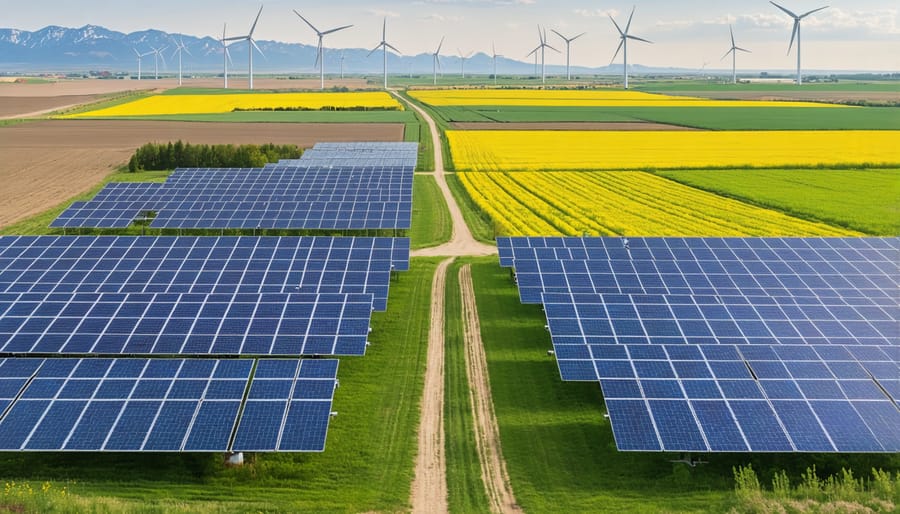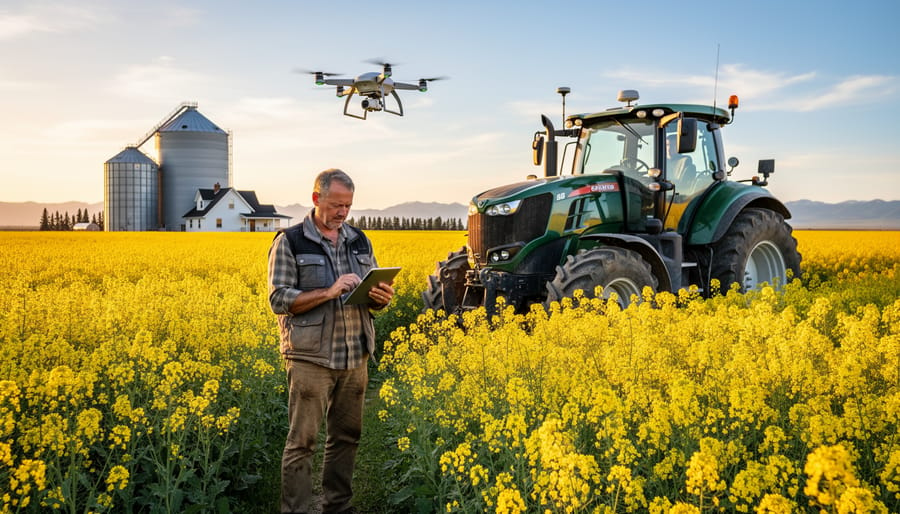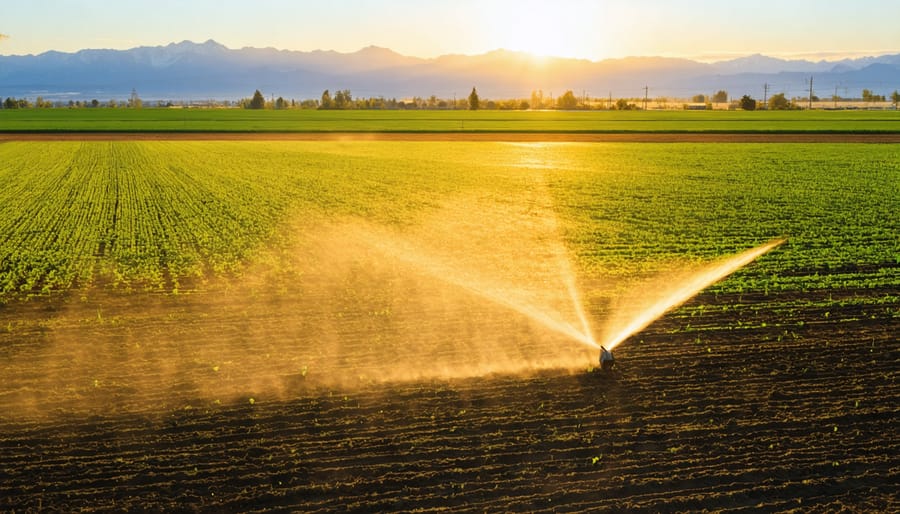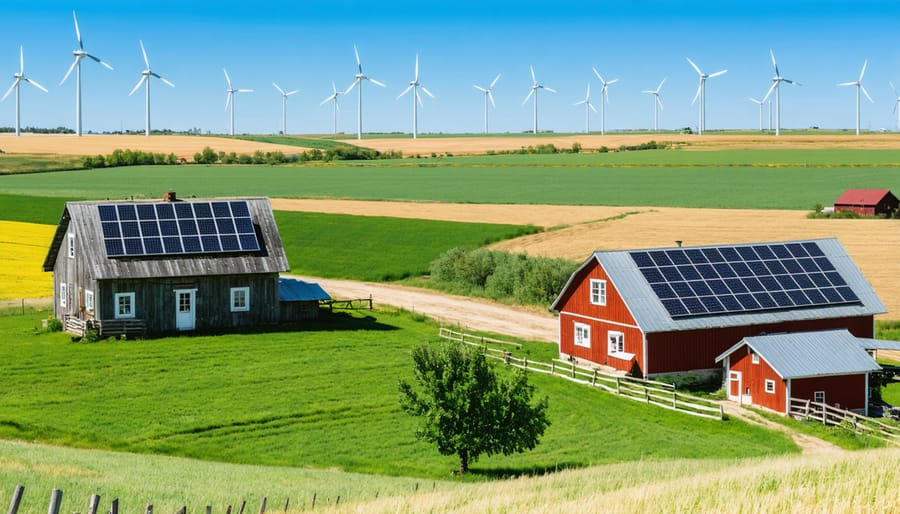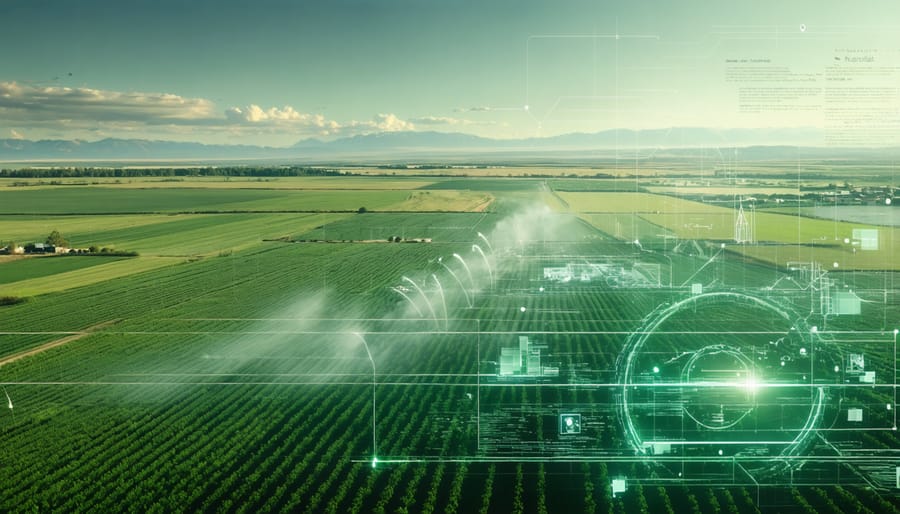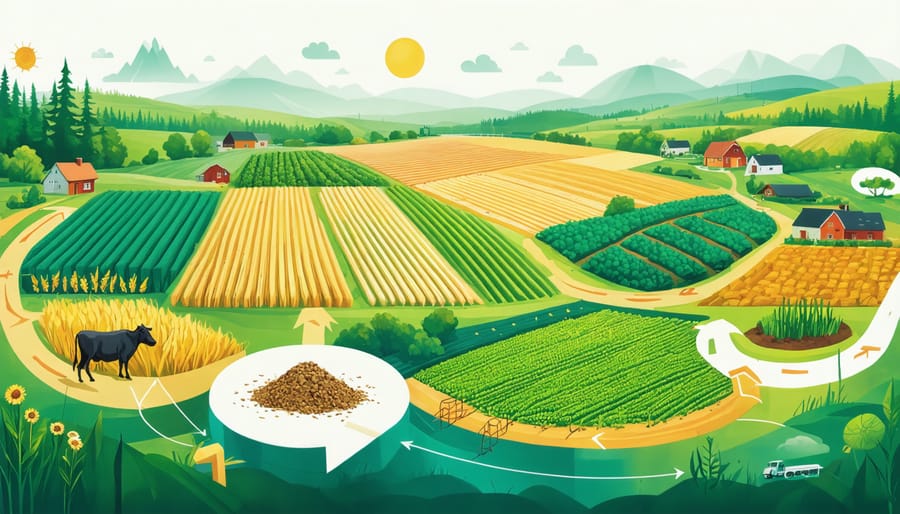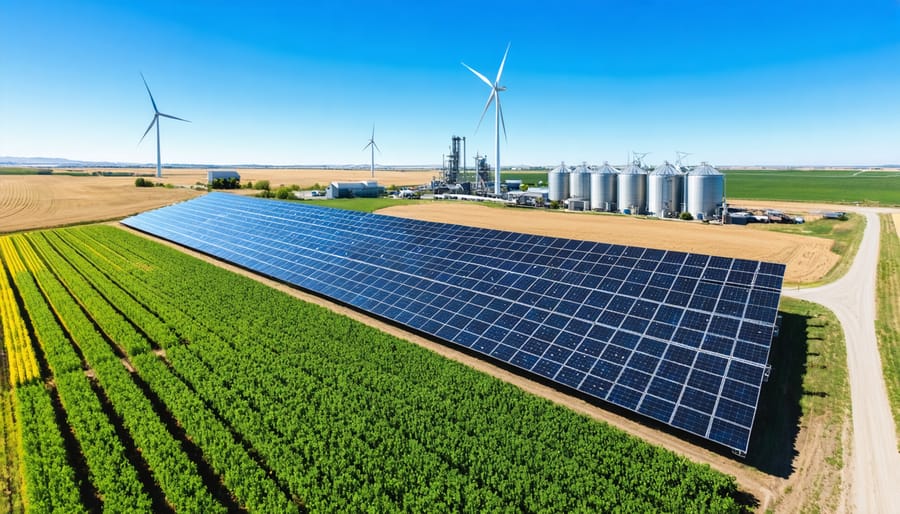Minnesota’s Renewable Energy Society (MRES) stands as a pioneering force in North America’s transition to sustainable power, offering valuable lessons for Canadian agricultural communities. Since 1978, MRES has transformed local energy landscapes through community-driven solar projects, wind initiatives, and innovative biomass solutions that specifically benefit farming operations.
For Alberta farmers watching Minnesota’s success, MRES demonstrates how agricultural communities can leverage renewable energy to reduce operational costs while creating new revenue streams. Their model of combining farmer-led cooperatives with technical expertise has resulted in over 200 successful agricultural renewable energy installations, with participating farms reporting average energy cost reductions of 40%.
The society’s practical approach to renewable implementation – focusing on farmer-to-farmer knowledge transfer, hands-on workshops, and direct technical support – provides a blueprint for Canadian agricultural communities. Their success in cold-climate solar installations and wind energy integration particularly resonates with Prairie farmers facing similar geographical and climate challenges.
This grassroots organization shows how agricultural communities can take control of their energy future while maintaining strong ties to traditional farming practices. Their experience offers concrete strategies for Canadian farmers looking to integrate renewable energy solutions while building resilient, sustainable agricultural operations.
Community Solar: A Game-Changer for Alberta Farms
Success Stories from Minnesota’s Model
Minnesota’s success with community solar projects offers valuable lessons for Alberta farmers looking to embrace renewable energy. The Wright-Hennepin Cooperative Electric Association’s solar project stands as a prime example, serving over 250 rural households while maintaining productive farmland through innovative agrivoltaic practices. Their dual-use approach allows sheep grazing between solar panels, demonstrating how renewable energy can complement existing agricultural operations.
In Waseca County, a 5-megawatt community solar garden initiated by local farmers has been powering 750 homes since 2018 while generating additional income for participating landowners. The project’s success stems from its cooperative structure, where farmers maintain ownership of their land while leasing portions for solar installations, earning approximately $1,200 per acre annually.
The Eichten Family Farms project in Chisago County showcases how dairy operations can benefit from solar integration. Their 40-hectare installation not only powers their dairy processing facility but also provides energy to 800 nearby homes. The project reduced their operational costs by 65% while creating natural shelter for their livestock during extreme weather conditions.
These Minnesota examples highlight key strategies that Alberta farmers can adapt: flexible land-use arrangements, community-based ownership models, and agricultural integration. The Minnesota Rural Electric Association reports that participating farmers maintain 95% of their land’s agricultural productivity while generating additional revenue through solar installations.
For Alberta farmers considering similar initiatives, these success stories demonstrate how community solar projects can create new revenue streams while supporting sustainable farming practices and strengthening rural energy independence.
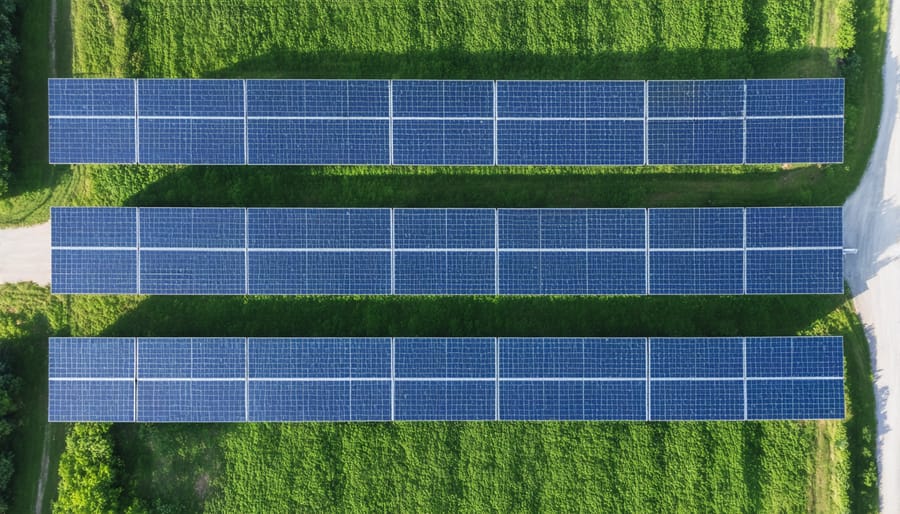
Benefits for Canadian Farm Communities
Canadian farm communities stand to gain substantial benefits from adopting renewable energy practices, similar to the successful models demonstrated by the Minnesota Renewable Energy Society. Local farmers have reported significant cost savings through community solar investments, with many Alberta operations reducing their annual energy expenses by 30-40%.
The economic advantages extend beyond direct energy savings. Farmers who implement renewable energy systems often qualify for federal and provincial grants, creating new revenue streams through power generation while maintaining their traditional agricultural operations. For instance, the Smith family farm near Lethbridge generates an additional $15,000 annually through their solar installation while continuing their wheat production.
Environmental benefits are equally impressive, with renewable energy systems helping farms reduce their carbon footprint and improve their sustainability credentials. This environmental stewardship often translates into marketing advantages, as consumers increasingly prefer products from environmentally responsible operations.
The community impact is particularly noteworthy. Renewable energy projects create local jobs in installation and maintenance, while keeping energy dollars within the community. Recent studies show that every dollar invested in local renewable energy generates $2.50 in regional economic activity.
For irrigation-dependent operations, solar-powered systems provide reliable water access while reducing operational costs. Many farmers report that combining renewable energy with modern agricultural practices has improved their farm’s resilience to climate variability and market fluctuations.
The collective purchasing power of farm communities also enables better negotiating positions with suppliers and installers, making renewable energy more accessible and affordable for all participants.
Implementing Renewable Energy Solutions on Your Farm
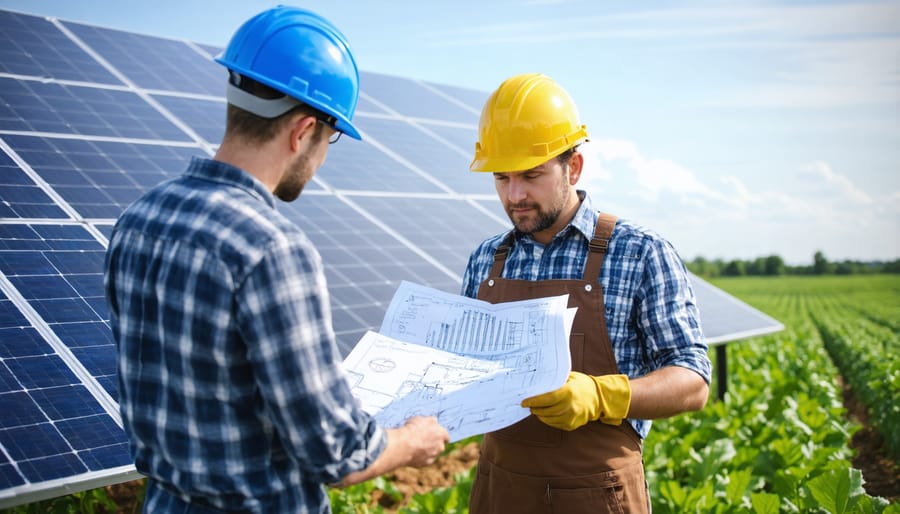
Getting Started: Assessment and Planning
Before diving into renewable energy projects, it’s essential to thoroughly assess your land’s potential and develop a comprehensive plan. Start by conducting a detailed site assessment of your agricultural property, taking note of available space, terrain features, and existing infrastructure. Consider factors like solar exposure, wind patterns, and proximity to power lines – elements that will significantly impact your project’s success.
Many Alberta farmers have found success by partnering with local energy consultants who understand both agricultural needs and renewable technologies. These experts can help evaluate your farm’s energy consumption patterns and identify opportunities for maximum impact. For example, the Thompson family farm near Lethbridge reduced their energy costs by 40% after a thorough assessment revealed ideal conditions for a hybrid solar-wind installation.
Create a detailed inventory of your current energy usage, including seasonal variations and peak demand periods. This data will help determine the appropriate size and type of renewable energy system for your needs. Consider both immediate requirements and potential future expansion of your farming operations.
Don’t forget to research available grants and incentives – many provinces offer support for agricultural renewable energy initiatives. Connect with local farming associations and renewable energy groups to learn from others’ experiences. Remember, successful implementation often starts with careful planning and community collaboration.
Begin with smaller, manageable projects that can be scaled up over time. This approach allows you to learn from experience while managing initial investments more effectively.
Funding and Support Resources
Alberta farmers looking to embrace renewable energy solutions have access to numerous financial support options. Through the available farming grants and incentives, transitioning to sustainable practices has become more achievable than ever.
The Environmental Stewardship and Climate Change Producer Program offers funding up to $100,000 for implementing renewable energy projects on farms. This program specifically supports solar panel installations, wind turbines, and biomass energy systems. Farmers can also access the Canadian Agricultural Partnership (CAP) funding, which provides cost-sharing opportunities for environmental improvements.
Local agricultural societies often provide matching funds and community-based support for renewable energy initiatives. The Rural Energy Program, administered through Alberta Agriculture and Forestry, offers technical assistance and financial support for energy audits and efficiency improvements.
For those interested in solar installations, the Alberta Solar Society provides educational resources and connects farmers with certified installers. They also offer workshops and mentorship programs to help farmers navigate the planning and implementation process.
Remember to consult with your local agricultural fieldman or renewable energy advisor to identify the most suitable funding options for your specific situation. Many programs offer application support and can help streamline the process of securing financial assistance for your renewable energy project.
Building Sustainable Agricultural Communities
Environmental Impact on Farm Operations
Renewable energy adoption on farms isn’t just about reducing energy costs – it’s transforming how we approach sustainable agriculture. Alberta farmers are discovering that implementing solar panels and wind turbines creates a ripple effect of environmental benefits throughout their operations. These technologies significantly reduce greenhouse gas emissions while supporting broader initiatives for climate action in agriculture.
Many farmers report that solar-powered irrigation systems have helped them maintain consistent crop yields while reducing water consumption by up to 30%. Wind turbines, strategically placed on farmland, generate clean energy without significantly impacting arable land use. These installations often create beneficial microclimates that protect crops and soil from extreme weather conditions.
The environmental benefits extend beyond emissions reduction. Solar panels provide shade for livestock, while wind turbines can help prevent soil erosion when properly positioned. Farmers using renewable energy often find themselves naturally transitioning to more sustainable practices, such as precision agriculture and conservation tillage.
Experience from Minnesota’s renewable energy initiatives shows that farms using solar and wind power typically reduce their carbon footprint by 40-60% within the first three years. These results are particularly relevant for Alberta farmers, who face similar climate challenges and agricultural conditions. By integrating renewable energy, farms become more resilient while contributing to Canada’s environmental goals.
Creating Local Energy Independence
Rural communities across Alberta are discovering the transformative power of renewable energy in creating self-sufficient, resilient local economies. Drawing inspiration from Minnesota’s successful local energy initiatives, Canadian farmers are implementing similar strategies to reduce dependence on external power sources.
The journey toward energy independence typically begins with community energy assessments, identifying available renewable resources like wind, solar, and biomass. Farmers are forming energy cooperatives, pooling resources to invest in shared infrastructure such as solar arrays and wind turbines. These collaborative efforts not only distribute costs but also create stronger community bonds.
Many rural communities are starting with smaller projects, such as installing solar panels on community buildings or implementing biomass heating systems using agricultural waste. These initial steps provide valuable learning experiences and build confidence for larger initiatives.
Key to success is the integration of energy storage solutions, such as battery systems or thermal storage, ensuring consistent power supply throughout the year. Local technical training programs are emerging to support maintenance and operations, creating new employment opportunities within communities.
The financial benefits are significant, with many communities reporting 30-40% reduction in energy costs within the first few years. This saved money stays within the local economy, supporting further community development and agricultural innovation.
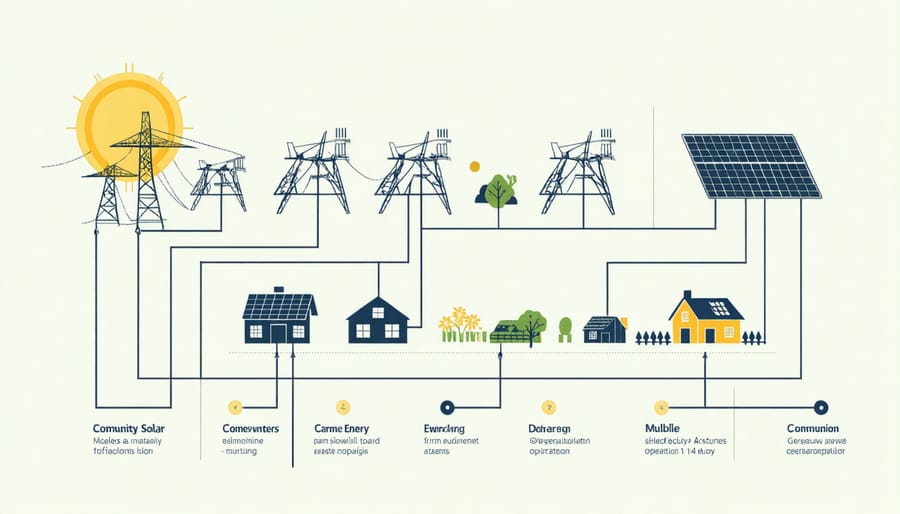
The success of Minnesota’s renewable energy initiatives offers valuable lessons for Alberta’s farming community. By embracing similar community-focused approaches, Alberta farmers can position themselves at the forefront of Canada’s sustainable agriculture movement. The key takeaway from Minnesota’s experience is that collective action and shared resources can make renewable energy adoption more accessible and economically viable for agricultural operations of all sizes.
As we’ve seen throughout this article, the benefits extend far beyond individual farms. Renewable energy projects strengthen rural communities, create local jobs, and provide long-term energy security. They also offer farmers additional revenue streams while contributing to Canada’s climate goals. The Minnesota model demonstrates that when farmers work together through cooperative structures, they can achieve economies of scale that make renewable energy projects more affordable and efficient.
Now is the time for Alberta farmers to take action. Start by connecting with local agricultural associations and exploring partnership opportunities with neighboring farms. Consider forming renewable energy cooperatives or joining existing initiatives in your region. Take advantage of available government incentives and funding programs for sustainable agriculture projects.
Remember, every successful renewable energy project starts with a single step. Whether it’s installing solar panels on your barn roof or participating in a community wind project, your contribution matters. Together, Alberta’s farming community can build a more sustainable and prosperous future while maintaining our proud agricultural heritage.
Contact your local agricultural extension office today to learn more about renewable energy opportunities in your area. The path to sustainable farming starts with you.

